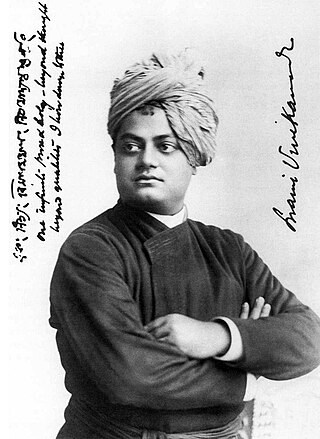
Swami Vivekananda, born Narendranath Datta, was an Indian Hindu monk, philosopher, author, religious teacher, and the chief disciple of the Indian mystic Ramakrishna. He was a key figure in the introduction of Vedanta and Yoga to the Western world, and the father of modern Indian nationalism who is credited with raising interfaith awareness and bringing Hinduism to the status of a major world religion.

Ramakrishna Paramahansa, also spelled Ramakrishna Paramahamsa, born Ramakrishna Chattopadhay was an Indian Hindu mystic. A devotee of the goddess Kali, Ramakrishna after adhering to various religious practices from the Hindu traditions of Vaishnavism, Tantric Shaktism, and Advaita Vedanta, as well as from Islam and Christianity, proclaimed that various world religions are "so many paths to reach one and the same goal", thus validating the essential unity of religions. His parable-based teachings espoused the ultimate unity of diverse religions as being means to enable the realization of the same God. He is regarded by his followers as an avatar or divine incarnation of God.
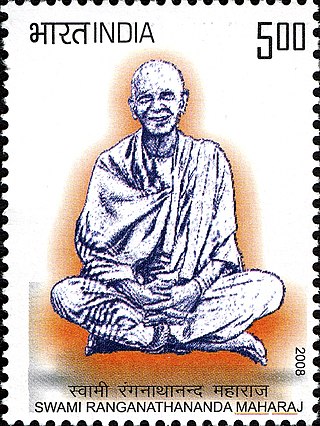
Swami Ranganathananda was a Hindu swami of the Ramakrishna Math order. He served as the 13th president of the Ramakrishna Math and Mission.

Shuddhananda who was the fifth president of the Ramakrishna Order, was a direct monastic disciple of Vivekananda. He joined the Ramakrishna Math in 1897. He became a trustee of Ramakrishna Math and a member of the governing body of Ramakrishna Mission in May 1903. He also took up the editorship of the Bengali magazine called Udbodhan for sometime. He was appointed as the secretary of the math and the mission in 1927 and as the vice president in 1937. In 1938, he became the president of the order. His tenure was short, as he died in 1938. He is renowned in the literary circles to have translated most of Vivekananda's original works from English to Bengali.

Swami Tapasyananda (1904-1991) was a senior monk of the Ramakrishna Mission. He was born in the Palat family of Ottapalam in Kerala, in 1904. His pre-monastic name was K. P. Balakrishnan Menon. In 1921, when he was just 17 years old, he met Swami Brahmananda- a direct disciple and spiritual son of Sri Ramakrishna, in Chennai. He received Mantra-Diksha from Swami Shivananda in 1924, and joined the Order in 1926, at 22 years age after completing in post graduation. In 1932, he received Sannyasa from Swami Shivananda. He was a disciple of Swami Shivananda, one of the eminent disciples of Sri Ramakrishna. The Swami was a vice-president of the Ramakrishna Order from 1985-1991, giving Mantra-Diksha to a large number of devotees. He was an erudite scholar in Indian and Western philosophy. He has to his credit many books in English, including the translations of many scriptures. His translation of Bhagavata Purana in four volumes has been highly acclaimed in intellectual and devotional circles. He was the president of Ramakrishna Math, Chennai from 1971-1991. Swamiji was well known for his austere life and intuitive intellect. His deity was Lord Khrishna and he practiced spiritual activity as told by his Guruji. He was a prolific writer. Some of the books authored by him are listed below. He translated many Hindu classics into English from original Sanskrit. He founded Ramakrishna Mission Hospital at Thiruvananthapuram.

Sister Nivedita was an Irish teacher, author, social activist, school founder and disciple of Swami Vivekananda. She spent her childhood and early youth in Ireland. She was engaged to marry a Welsh youth, but he died soon after their engagement.

Vedanta Societies refer to organizations, groups, or societies formed for the study, practice, and propagation of Vedanta, the culmination of Vedas. More specifically, they "comprise the American arm of the Indian Ramakrishna movement", and refer to branches of the Ramakrishna Order located outside India.
Ramakrishna (1836–1886) was a 19th-century Indian mystic whose teachings form the foundation of the Ramakrishna religious movement, Ramakrishna Order and Ramakrishna Mission.
Ramakrishna (1836–1886) is a famous mystic of nineteenth-century India. Ramakrishna never wrote down the details of his own life. Sources for his life and teachings come from the writings of his disciples and live witnesses. Ramakrishna's recorded sayings mainly come from the last four years of his life.

Sister Gargi, born Marie Louise Burke, was a writer and an eminent researcher on Swami Vivekananda, and a leading literary figure of the Ramakrishna-Vivekananda movement. Gargi was introduced to the Ramakrishna-Vivekananda movement in 1948 by Swami Ashokananda. She is known for her six-volume work, Swami Vivekananda in the West: New Discoveries. Her New Discoveries are considered as indispensable for Swami Vivekananda research.
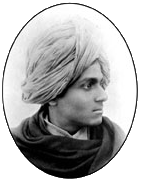
Swarupananda was a direct monastic disciple of Vivekananda and the first president of the Advaita Ashrama, set up by Vivekananda in 1899 at Mayavati, near Champawat. The ashram is a branch of the religious monastic order, Ramakrishna Math, also set up by Vivekananda on the teachings of his guru Ramakrishna.
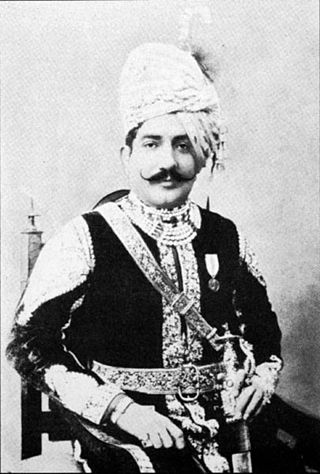
Raja Ajit Singh Bahadur was the ruler of the Shekhawat estate (thikana) of Khetri at Panchpana in Rajasthan between 1870 and 1901. He was born on 16 October 1861 at Alsisar. His father was Thakur Chattu Singh, a resident of Alsisar. Ajit Singh was later adopted to Khetri and after the death of Fateh Singh, he became the eighth king of Khetri in 1870. In 1876, he married Rani Champawatiji Sahiba and the couple had one son and two daughters. He died on 18 January 1901 due to an accident at the tomb of Akbar in Sikandra near Agra and was cremated at Mathura.

Swami Vivekananda was a Hindu monk from India. His teachings and philosophy are a reinterpretation and synthesis of various strands of Hindu thought, most notably classical yoga and (Advaita) Vedanta, with western esotericism and Universalism. He blended religion with nationalism, and applied this reinterpretation to various aspect's of education, faith, character building as well as social issues pertaining to India. His influence extended also to the west, and he was instrumental in introducing Yoga to the west.

Josephine MacLeod was an American friend and devotee of Swami Vivekananda. She had a strong attachment to India and was an active participant in the Ramakrishna Vivekananda movement. She was given the nicknames "Tantine" and "Jo Jo" by Vivekananda. She considered Swami Vivekananda to be her friend and helped him with his finances. MacLeod was not a sanyasin, unlike many others such as Sister Nivedita or Sister Christine. She was instrumental in spreading Vivekananda's message on Vedanta in the West. She made many contributions to the initial and the later phases of the development of the order of Ramakrishna and Vivekananda. She was a contributor to many causes espoused by Sister Nivedita, the most famous disciple of Vivekananda, including that of contributing financially towards the development of the Indian National Movement especially in Bengal and elsewhere in India.

Swami Vivekananda represented India and Hinduism at the Parliament of the World's Religions (1893). India Celebrates National youth day on birth anniversary of the Great Swami. This was the first World's Parliament of Religions, and it was held from 11 to 27 September 1893. Delegates from all over the world joined this Parliament. In 2012 a three-day world conference was organized to commemorate 150th birth anniversary of Vivekananda.

The Song of the Sannyasin is a poem of thirteen stanzas written by Swami Vivekananda. Vivekananda composed the poem in July 1895 when he was delivering a series of lectures to a groups of selected disciples at the Thousand Island Park, New York. In the poem he defined the ideals of Sannyasa or monastic life.
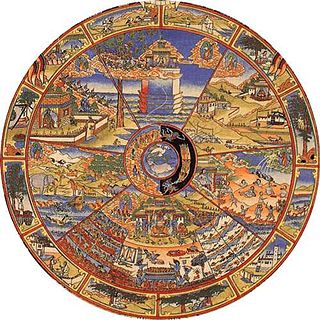
"My Play is Done" is a poem written by Swami Vivekananda. He wrote the poem in the Spring of 1895 in New York. In this poem, Vivekananda expressed his strong desire to return home. As he felt, the task of spreading his Master's message abroad was finally accomplished.

Swami Vivekananda, the nineteenth-century Indian Hindu monk, is considered one of the most influential people of modern India and Hinduism. Rabindranath Tagore suggested to study Vivekananda's works to learn about India. Indian independence activist Subhas Chandra Bose regarded Vivekananda as his spiritual teacher. Mahatma Gandhi said that after reading the works of Vivekananda, his love for his nation became a thousand-fold.
Meditation played a very important role in the life and teachings of Swami Vivekananda. He was interested in meditation from his childhood. His master Ramakrishna found him a dhyana - siddha . On 24 December 1892, Vivekananda reached Kanyakumari and meditated for three days on a large rock and took the resolution to dedicate his life to serve humanity. The event is known as the Kanyakumari resolve of 1892. He reportedly also meditated for a long time on the day of his death.

The relationship between Ramakrishna and Vivekananda began in November 1881, when they met at the house of Surendra Nath Mitra. Ramakrishna asked Narendranath to sing. Impressed by his singing talent, he invited him to Dakshineswar. Narendra accepted the invitation, and the meeting proved to be a turning point in the life of Narendranath. Initially Narendra did not accept Ramakrishna as his master and found him to be a "mono maniac", but eventually he became one of the closest people in his life. Ramakrishna reportedly shaped the personality of Narendranath and prepared him to dedicate his life to serve humanity. After the death of Ramakrishna, Narendra and his other monastic disciples established their first monastery at Baranagar.
















